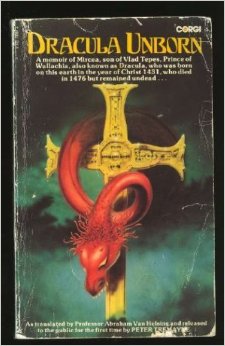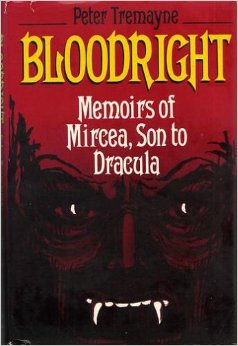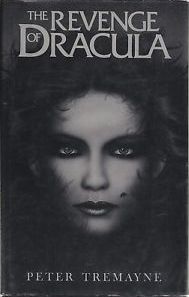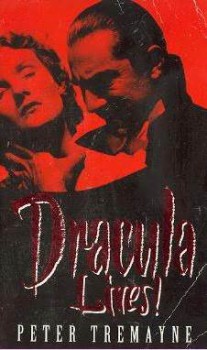Peter Tremayne’s Dracula Lives Trilogy Revisited
NOTE: The following article was first published on February 14, 2010. Thank you to John O’Neill for agreeing to reprint these early articles, so they are archived at Black Gate which has been my home for over 5 years and 250 articles now. Thank you to Deuce Richardson without whom I never would have found my way. Minor editorial changes have been made in some cases to the original text.

 It has long been my contention that pulp fiction not discovered by age thirteen was beyond my ability to appreciate later in life. A certain amount of nostalgia seemed essential to enjoying such escapism once age and responsibility have got the better of you. There are, of course, exceptions to this rule in the rare instances where genuine literary talent is in evidence as is the case with the Holy Trinity of hardboiled detective fiction: Dashiell Hammett, Raymond Chandler, and Ross Macdonald. Given that I recently covered Bram Stoker’s Dracula, I decided to revisit Peter Tremayne’s three Dracula novels and one short story that I enjoyed so much as a teenager to see how they held up three decades on.
It has long been my contention that pulp fiction not discovered by age thirteen was beyond my ability to appreciate later in life. A certain amount of nostalgia seemed essential to enjoying such escapism once age and responsibility have got the better of you. There are, of course, exceptions to this rule in the rare instances where genuine literary talent is in evidence as is the case with the Holy Trinity of hardboiled detective fiction: Dashiell Hammett, Raymond Chandler, and Ross Macdonald. Given that I recently covered Bram Stoker’s Dracula, I decided to revisit Peter Tremayne’s three Dracula novels and one short story that I enjoyed so much as a teenager to see how they held up three decades on.
Peter Tremayne is best known today for his long-running Sister Fidelma mysteries. His medieval detective series is sort of a lightweight version of an Umberto Eco doorstop. Although Tremayne’s real world credentials are quite impressive as both an academic and scholar, his fiction is strictly populist in its appeal. Turn back the clock 40 years and one would find Peter Tremayne as a dedicated pulp pastiche writer trying his hand at extending the lifespan of H. Rider Haggard’s She, deliriously combining Shelley’s Frankenstein with Conan Doyle’s Hound of the Baskervilles, and delving deep into Stoker’s Dracula for a trilogy of loosely connected titles published by Bailey Brothers in the UK.
The first of the trilogy, Dracula Unborn (US title: Bloodright) was written in 1974 and first published in 1977. Tremayne starts the story off with the author himself discovering a manuscript belonging to Stoker’s fictional Dr. Seward at a swap meet in Islington. The manuscript, it turns out, is a translation by Professor Abraham Van Helsing of the late 15th Century memoir of Mircea Dracula, the youngest son of the historical Vlad Tepes. From there the story moves rapidly from the modern world referencing Stoker and actual Romanian history to Mircea’s autobiography which reads, in the first few chapters, like a pastiche of a classic swashbuckler.
Mircea is living the life of a nobleman in Rome under the name of Michelino. He was raised in Italy after his mother fled Wallachia when he was a baby. Michelino is just the sort of rogue beloved by Dumas or Sabatini in their classic swashbucklers. He is an excellent swordsman lacking in all scruples who thinks nothing of seducing a married woman as a means of settling a score with her husband. Fleeing an assassin set on his tail by the cuckolded husband (it’s an unwritten rule that such characters never consider the likely consequences of their reckless actions), Michelino reverts to his true identity as Mircea Dracula and returns to the family home in Wallachia as Tremayne switches genres on the reader yet again.
Moving from the splendour of Roman villas to hoary old Transylvania with it’s superstitious villagers and cobwebbed castles, Tremayne fails to evoke the effectiveness Stoker demonstrated in contrasting the New World with the Old. Instead the reader is given the awkward feeling of channel surfing between classic movie stations. Part of the problem is the unavoidable feeling that the material is overly familiar. Tremayne recycles incidents and dialogue from Stoker’s book and evokes scenes from Universal horror films of the 1930s and 1940s as well as Hammer horror films of the 1950s and 1960s.
It must be said, to Tremayne’s credit, that upon publication Dracula Unborn was virtually unique. It may very well have been the first novel to fully integrate Stoker’s vampire with the historical despot known as Vlad the Impaler. Today, the well-read Dracula aficionado will recognize Radu Florescu and Raymond McNally’s research on Vlad Tepes being regurgitated nearly word for word in the pages of Tremayne’s book. The book’s main interest for modern readers lies in spotting the similarities (likely coincidental) between Tremayne and Jeanne Kalogridis’ Diaries of the Family Dracul trilogy from the 1990s (books that are far too derivative of Anne Rice’s Vampire Chronicles for my taste despite Kalogridis’ undeniable writing talent).
 Tremayne improved the second time out with The Revenge of Dracula (1978). Despite the rather silly title and even more raiding of dialogue and incidents from Stoker and monster movies of decades past, this is a fun pulp novel. I would go so far as to say that I was sorry Tremayne tied Dracula into the proceedings at all as it would have stood on its own easily as a thrilling weird mystery with no need for any vampire to make an appearance. Once again, Tremayne starts the story with the author himself receiving a manuscript. This time, the story originates with a psychiatrist who takes Tremayne to task for writing horror fiction by demonstrating the negative impact such work can have on impressionable minds. Case in point is a 19th Century memoir by Upton Wellsford, a vicar’s son who toils in a lowly clerical position in the Foreign Office.
Tremayne improved the second time out with The Revenge of Dracula (1978). Despite the rather silly title and even more raiding of dialogue and incidents from Stoker and monster movies of decades past, this is a fun pulp novel. I would go so far as to say that I was sorry Tremayne tied Dracula into the proceedings at all as it would have stood on its own easily as a thrilling weird mystery with no need for any vampire to make an appearance. Once again, Tremayne starts the story with the author himself receiving a manuscript. This time, the story originates with a psychiatrist who takes Tremayne to task for writing horror fiction by demonstrating the negative impact such work can have on impressionable minds. Case in point is a 19th Century memoir by Upton Wellsford, a vicar’s son who toils in a lowly clerical position in the Foreign Office.
Upton has little use for God or country and is clearly destined to pay the price for his hubris. Of course, before the natural order is restored we get plenty of fun along the way. Upton buys an antique from a curio shop. A carved dragon that he suspects is Chinese in origin and, more importantly, pure jade despite the shopkeeper’s ignorance. Gloating over his valuable find, Upton is troubled by insomnia and strange dreams from this point forward in the narrative. Upton’s recurring dream is that he is a pagan priest about to be sacrificed by a beautiful pagan priestess. Of course, Upton is the reincarnation of the honorable Egyptian priest, Ki who was sacrificed to the demon Draco by his lover, Queen Sebek-nefer-Ra centuries earlier. In due course, Upton meets his dream girl, Clara Clarke and falls in love. She is the reincarnation of Sebek-nefer-Ra and has been sharing the same recurring dream as Upton.
Along the way we meet Upton’s best friend, an amateur occultist who foolishly thinks he can contain the power held in the jade dragon. The Foreign Office sends Upton packing to Romania to attend the Coronation. By the time Dracula finally turns up, I was actually resentful. Tremayne does such a great job evoking the weird fiction prevalent in Victorian and Edwardian England that a vampire seems superfluous. Tremayne takes the reader along on an emotional roller coaster as Upton and Clara barely escape Dracula with their lives only to suffer hardship in later years before meeting their tragic fates. It’s a bit of a downer, but a nice sting at the end with the psychiatrist’s letter to Tremayne deriding horror fiction as utter nonsense unworthy of serious attention.
A peculiar postscript of sorts exists with the short story, “Dracula’s Chair” (1979). Tremayne definitely suffered for poor titles early in his career. This short piece is largely unintelligible to the reader who hasn’t read The Revenge of Dracula first, but it would have been one wrinkle too many had it been included as a further epilogue as Tremayne originally intended. Once again, the author places himself in the story as his wife picks up a Victorian chair for him at an antique shop. Once seated in the chair (which belonged to Upton Wellsford, ironically), Tremayne and Wellsford mystically switch souls with Tremayne fated to die at Dracula’s hand in Wellsford’s body at the horrific conclusion of The Revenge of Dracula with the knowledge that Wellsford has escaped death to live out the rest of his life in the future as Peter Tremayne, bestselling author.
 Tremayne’s final visit to the character was with Dracula, My Love (1980). Once again, his predilection for dreadful titles hampers him. The cover art and jacket blurb for the UK edition promise a Victorian version of Twilight with Dracula falling in love with a proto-feminist. Happily, the book isn’t quite that bad. This is really a novella rather than a full-length novel. Tremayne is back to introduce the novel as he is visited by Serban Mitikelu, a Romanian monk who passes on the memoir of Morag MacLeod, a Victorian Scotswoman. The monk is killed by a vampire after leaving Tremayne’s apartment. This is revealed at the end of Tremayne’s prologue. He would have been better served saving the scene for a suitably creepy epilogue.
Tremayne’s final visit to the character was with Dracula, My Love (1980). Once again, his predilection for dreadful titles hampers him. The cover art and jacket blurb for the UK edition promise a Victorian version of Twilight with Dracula falling in love with a proto-feminist. Happily, the book isn’t quite that bad. This is really a novella rather than a full-length novel. Tremayne is back to introduce the novel as he is visited by Serban Mitikelu, a Romanian monk who passes on the memoir of Morag MacLeod, a Victorian Scotswoman. The monk is killed by a vampire after leaving Tremayne’s apartment. This is revealed at the end of Tremayne’s prologue. He would have been better served saving the scene for a suitably creepy epilogue.
Morag’s life reads like a bowdlerized version of Victorian pornography as she suffers rape and maltreatment at the hand of one cruel lord and squire after another. Happily, these incidents are not rendered in explicit detail, but they are still unpleasant enough to make the reader resent female humiliation being packaged for titillation.
Of course, if there’s one thing Tremayne can be counted on, it’s for giving his libertine characters a proper Victorian comeuppance and Morag is no exception. When she falls in love, you can bet she will become pregnant, the father will die before they can wed, and his family will disown her as the harlot who seduced their poor son. Inevitably, Morag finds her way to Transylvania and Castle Dracula. The third time round, Tremayne’s take on Dracula’s household is so familiar that it reads like a parody of what has gone before. There is a romance between heroine and vampire, but it is not really as Barbara Cartland as the jacket blurb scares the reader into believing.
What really kills the book isn’t the ridiculous romance, it is Tremayne’s insistence on shoehorning the historical Countess Elisabeth Bathory and Abraham Van Helsing into the proceedings. I know he’s trying to set up Stoker’s book (Kalogridis took the same approach with her trilogy), the trouble is (as with Kalogridis) they make too much of Dracula’s family history and home life. The sheer number of characters and their muddled pasts (it turns out Dracula is actually Egyptian for starters) makes one wish Tremayne had used all original characters.
When all is said and done, Tremayne’s take on the material is his own and bears little resemblance to Stoker outside of what he chooses to steal. I happily choose pulp fiction over literature any day, but much as it pains me to admit, Tom Wolfe was right, sometimes you can’t go home again. Despite a near perfect pulp novel with the second book, Tremayne’s trilogy (and the lone short story) are not worthy of Dracula’s noble title.
William Patrick Maynard was authorized to continue Sax Rohmer’s Fu Manchu thrillers beginning with The Terror of Fu Manchu (2009; Black Coat Press) and The Destiny of Fu Manchu (2012; Black Coat Press). His long-delayed third title, The Triumph of Fu Manchu is coming soon from Black Coat Press.